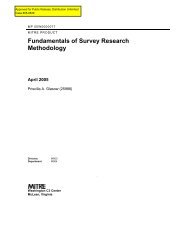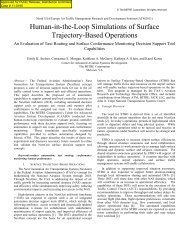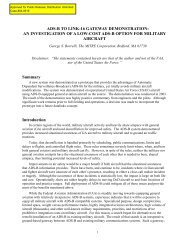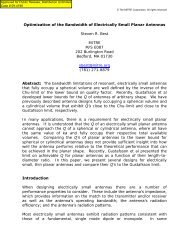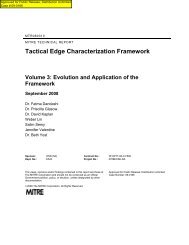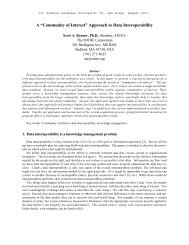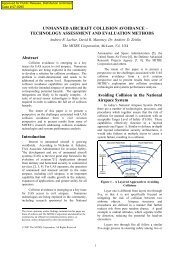A Predictive Model of User Equipage Costs for Future Air ... - Mitre
A Predictive Model of User Equipage Costs for Future Air ... - Mitre
A Predictive Model of User Equipage Costs for Future Air ... - Mitre
You also want an ePaper? Increase the reach of your titles
YUMPU automatically turns print PDFs into web optimized ePapers that Google loves.
2.2 General Aviation<br />
The GA model is based on a three step process:<br />
• Forecast the GA fleet’s composition through the time period <strong>of</strong> the study.<br />
• Determine current avionics equipage <strong>of</strong> the fleet.<br />
• Project fleet avionics equipage <strong>for</strong> each year <strong>of</strong> the study based on re-equipage <strong>of</strong><br />
existing fleet aircraft, retirement <strong>of</strong> older aircraft, and addition <strong>of</strong> new aircraft.<br />
Forecasting GA fleet equipage is a complex, multi-step process. While the FAA has made ef<strong>for</strong>ts<br />
to predict raw GA aircraft counts through a portion <strong>of</strong> the study period, no such projection is<br />
available <strong>for</strong> avionics configuration, or <strong>for</strong> the flow <strong>of</strong> new aircraft into the fleet and retired<br />
aircraft out.<br />
To allow these estimates to be made, the team used the following methodology:<br />
• Identify current GA fleet count and composition.<br />
• Estimate existing ADS-B avionics base, to include ADS-B data link, displays with<br />
the capability to display ADS-B applications, and Global Positioning System (GPS)<br />
navigation systems.<br />
• Project fleet count and composition using FAA GA <strong>for</strong>ecasts (2003–2014) and FAA<br />
long range <strong>for</strong>ecasts (2015–2020).<br />
• Determine new aircraft deliveries in each category <strong>for</strong> the 2003–2020 period using<br />
General Aviation Manufacturers Association (GAMA) and FAA projections, as well<br />
as historical trends based on GAMA new aircraft delivery statistics.<br />
• Determine new aircraft ADS-B avionics configuration based on manufacturerannounced<br />
equipage and observed trends.<br />
• Determine retirements in each category.<br />
• Categorize each aircraft in the model by ADS-B equipage status.<br />
• Estimate number <strong>of</strong> aircraft transitioning between ADS-B equipage states by year.<br />
• Use fleet composition, estimated equipage, and yearly transition rates to determine<br />
total number <strong>of</strong> aircraft in each ADS-B equipage category by year.<br />
The General Aviation <strong>for</strong>ecast is contained in Appendix B.<br />
2.2.1 <strong>Air</strong>craft <strong>Model</strong> Categorization<br />
The GA fleet is composed <strong>of</strong> well over 200,000 aircraft, and may be categorized in a number <strong>of</strong><br />
ways, ranging from usage (e.g., charter, instruction, Emergency Medical Service, etc.) to purely<br />
physical characteristics, such as maximum take-<strong>of</strong>f weight. The method chosen by the team<br />
2-4



